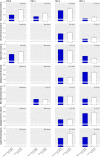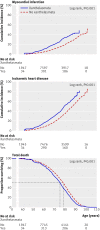Xanthelasmata, arcus corneae, and ischaemic vascular disease and death in general population: prospective cohort study
- PMID: 21920887
- PMCID: PMC3174271
- DOI: 10.1136/bmj.d5497
Xanthelasmata, arcus corneae, and ischaemic vascular disease and death in general population: prospective cohort study
Abstract
Objective: To test the hypothesis that xanthelasmata and arcus corneae, individually and combined, predict risk of ischaemic vascular disease and death in the general population.
Design: Prospective population based cohort study.
Setting: The Copenhagen City Heart Study.
Participants: 12,745 people aged 20-93 years free of ischaemic vascular disease at baseline and followed from 1976-8 until May 2009 with 100% complete follow-up.
Main outcome measures: Hazard ratios for myocardial infarction, ischaemic heart disease, ischaemic stroke, ischaemic cerebrovascular disease, and death; odds ratios for severe atherosclerosis.
Results: 563 (4.4%) of participants had xanthelasmata and 3159 (24.8%) had arcus corneae at baseline. During 33 years' follow-up (mean 22 years), 1872 developed myocardial infarction, 3699 developed ischaemic heart disease, 1498 developed ischaemic stroke, 1815 developed ischaemic cerebrovascular disease, and 8507 died. Multifactorially adjusted hazard/odds ratios for people with versus those without xanthelasmata were 1.48 (95% confidence interval 1.23 to 1.79) for myocardial infarction, 1.39 (1.20 to 1.60) for ischaemic heart disease, 0.94 (0.73 to 1.21) for ischaemic stroke, 0.91 (0.72 to 1.15) for ischaemic cerebrovascular disease, 1.69 (1.03 to 2.79) for severe atherosclerosis, and 1.14 (1.04 to 1.26) for death. The corresponding hazard/odds ratios for people with versus those without arcus corneae were non-significant. In people with versus those without both xanthelasmata and arcus corneae, hazard/odds ratios were 1.47 (1.09 to 1.99) for myocardial infarction, 1.56 (1.25 to 1.94) for ischaemic heart disease, 0.87 (0.57 to 1.31) for ischaemic stroke, 0.86 (0.58 to 1.26) for ischaemic cerebrovascular disease, 2.75 (0.75 to 10.1) for severe atherosclerosis, and 1.09 (0.93 to 1.28) for death. In all age groups in both women and men, absolute 10 year risk of myocardial infarction, ischaemic heart disease, and death increased in the presence of xanthelasmata. The highest absolute 10 year risks of ischaemic heart disease of 53% and 41% were found in men aged 70-79 years with and without xanthelasmata. Corresponding values in women were 35% and 27%.
Conclusion: Xanthelasmata predict risk of myocardial infarction, ischaemic heart disease, severe atherosclerosis, and death in the general population, independently of well known cardiovascular risk factors, including plasma cholesterol and triglyceride concentrations. In contrast, arcus corneae is not an important independent predictor of risk.
Conflict of interest statement
Competing interests: All authors have completed the Unified Competing Interest form at
Figures




Comment in
-
Eye markers of cardiovascular disease.BMJ. 2011 Sep 15;343:d5304. doi: 10.1136/bmj.d5304. BMJ. 2011. PMID: 21920886 No abstract available.
References
-
- Bergman R. The pathogenesis and clinical significance of xanthelasma palpebrarum. J Am Acad Dermatol 1994;30:236-42. - PubMed
-
- Fernández A, Sorokin A, Thompson PD. Corneal arcus as coronary artery disease risk factor. Atherosclerosis 2007;193:235-40. - PubMed
-
- Segal P, Insull W Jr, Chambless LE, Stinnett S, LaRosa JC, Weissfeld L, et al. The association of dyslipoproteinemia with corneal arcus and xanthelasma: the Lipid Research Clinics Program Prevalence Study. Circulation 1986;73:I108-18. - PubMed
-
- Kahán A, Kahán IL, Timár V. Lipid anomalies in cases of xanthelasma. Am J Ophthalmol 1967;63:320-5. - PubMed
